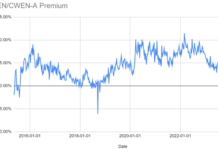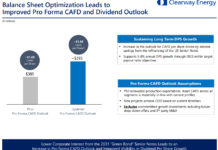Tom Konrad CFA
U.S.-listed YieldCos seem to offer the best of two worlds: high income from dividends, combined with high dividend per share growth.
YieldCos are listed companies that own clean energy assets, and like the real estate investment trusts (REITs) and master limited partnerships (MLPs) they are modeled after, they return almost all the income from their investments to their shareholders in the form of dividends. Unlike REITs and MLPs, however, U.S.-listed YieldCos have management targets to deliver double-digit per-share dividend growth.

YieldCos shown are NRG Yield (NYLD), Abengoa Yield (ABY), TerraForm Power (TERP), NextEra Energy Partners (NEP), Hannon Armstrong (HASI), Pattern Energy Group (PEGI), Brookfield Renewable Energy (BEP), and TransAlta Renewables (TSX:RNW, OTC:TRSWF).
Historic growth rates are not shown for some YieldCos because they have only been paying dividends for less than a full year. Dividend growth targets are not shown for TransAlta Renewables because the company’s management has not issued explicit targets. The data shown is drawn from company financial filings.
In contrast, growth rates above 10 percent for REITs and MLPs are virtually unheard of, but they are the norm for U.S.-listed YieldCos.
Sources of dividend growth
Companies can achieve per-share dividend growth in a number of ways: normal increases in income from existing business; reinvesting money generated by the business; and investing money from new share issuance.
In the case of YieldCos, income from existing clean energy facilities can increase because of inflation escalators built into the power-purchase agreements (PPAs), or if the YieldCo invests to increase power production. PPA escalators tend to be low (2 percent or less.)
Aside from the natural increase in cash flow from escalators in existing PPAs, a YieldCo can raise its cash flow available for distribution (CAFD) per share by increasing invested capital per share. Companies often increase invested capital per share by investing some available cash flow. This increases future dividends at the expense of current yield. Since most YieldCos distribute nearly all of their available cash flow, this is not a significant contributor to dividend growth.
Instead, YieldCos typically issue new shares to pay for new investments. Because most YieldCos have seen significant price appreciation since their IPOs, new shares can be sold for higher prices than previous shares. Share issues always provide more capital for a company to invest. When those shares are sold at higher prices, they also increase the per-share capital.
The following chart shows how the three oldest U.S. YieldCos have been able to increase the issue price of secondary offerings over time.
By selling new shares to the public, many YieldCos have been able to achieve the high per-share dividend growth rates shown in the first chart.
High dividend growth
In theory, as long as their share prices keep rising, YieldCos will be able to maintain their historic high dividend growth rates forever.
In fact, recent price rises mean that dividend growth can continue for some time even without further share appreciation. The chart below shows the expected per-share dividend increase which would arise from investing the proceeds of a share issue at the current stock price, along with the YieldCos’ stated growth targets.
In the chart, a “percentage share increase” means issuing a number of shares, which is the percentage of the shares currently outstanding. For instance, if a YieldCo has 10 million shares outstanding, issuing 2 million shares would be a 20 percent increase, 5 million new shares would be a 50 percent increase, and 10 million new shares would be a 100 percent increase.
The effects of larger-percentage stock issues are not shown in the chart if the YieldCo is already so large that the new issue would exceed $2 billion. This is because investors would not be willing to buy so much new stock quickly, and the YieldCo would have trouble finding so many attractive projects to invest in quickly.
The $2 billion number is arbitrary, but I chose it because the largest YieldCo acquisition to date was TransAlta Renewables purchase of $1.78 billion worth of assets in Western Australia from its parent company TransAlta. Most YieldCo acquisitions are much smaller, and no YieldCo has bought more than $2 billion worth of assets during its history as a public company.
As you can see in the chart above, the U.S.-listed YieldCos NRG Yield, Abengoa Yield, TerraForm Power, and NextEra Energy Partners have the greatest potential for percentage increases in their per-share dividends.
The U.S.-listed REIT Hannon Armstrong, which is very similar to the YieldCo despite its REIT structure, and the dual-listed YieldCos Pattern Energy Group and Brookfield Renewable Energy Partners also have good potential and target percentage growth rates. From the perspective of growth potential, the Canadian-listed YieldCo TransAlta Renewables is far behind. It also lacks specific per-share growth targets.
Not high yield
These impressive per-share growth rates disguise the vulnerability of relying on new share issuance for new investment. The share price increases necessary to perpetuate rapidly growing distributions also reduce the yield. This is because yield is simply distributions per share divided by the share price.
Unless the share price falls, the amount of invested capital from share issuance will never exceed the share price, and so the dividend yield will remain below the YieldCo’s cash-on-cash returns from new investments.
As we have seen here and in the chart below, YieldCos’ new investments have cash-on-cash returns in the 7 percent to 9 percent range.
Despite the potential for rapid percentage dividend growth, the 7 percent to 9 percent range for YieldCo returns on investment will also cap future yields. No YieldCo can have a higher distribution yield unless its price falls, or it starts to reinvest some of its cash flow into the business, which would cause its yield to fall in the short term.
This final chart is similar to the Model Growth In YieldCo distributions chart above, except that here the dividends are shown as a yield on the current share price.
From the perspective of current and potential future yield at the current share price, the U.S.-listed YieldCos suddenly seem much less impressive. In fact, the previous apparent laggard, TransAlta Renewables, already has a current yield as high as the yield which the best other YieldCos hope to achieve after two more years.
Even if their impressive dividend growth rates continue, the U.S.-listed YieldCos are many years from achieving yields comparable to TransAlta Renewables’ yield today.
More bad news
The illusion of rapid dividend growth is not the only bad news. TerraForm Power, NextEra Energy Partners, and Brookfield Renewable have incentive distribution rights (IDRs) which give the YieldCo’s parent company (General Partner) a growing percentage of distributions when those distributions exceed certain levels per share. TerraForm’s IDR will begin to take effect when the quarterly dividend hits 34 cents per share (it’s currently 32 cents), and it will rise to 50 percent of distribution increases when it hits 45 cents.
NextEra Energy Partners’ IDR Fee will begin to take effect when quarterly dividends reach 21.6 cents (currently 19.5 cents). It will rise to half of distribution increases when dividends reach 28.1 cents.
Brookfield’s incentive distributions are currently in effect, with the parent Brookfield Asset Management currently receiving 15 percent of quarterly distributions in excess of 37.5 cents. This incentive will soon rise to 25 percent when quarterly dividends exceed 42.25 cents per share. Dividends are currently 41 cents, so the 25 percent threshold will likely be met soon.

YieldCos’ parent companies justify IDRs because they supposedly align the parents’ interests with the YieldCos’ shareholders. Since the parents have complete control, and are often the sellers of the clean energy facilities which YieldCos buy, this is not an unreasonable argument. On the other hand, as long as YieldCos are using new share offerings at ever higher prices to increase distributions, IDRs are essentially an incentive to just do more deals using other people’s money.
IDRs would do a much better job of aligning the parties’ interests if they were defined in terms of distributions as a percentage of the average price at which shares had been issued. As it is, IDRs create a perverse incentive to issue more shares whenever the stock price is high relative to previous issuance.
IDRs will reduce potential yields at these three YieldCos.
Conclusion
Investors have been seduced by rapid percentage dividend growth targets at the U.S.-listed YieldCos NRG Yield, NextEra Energy Partners, TerraForm Power, and Abengoa Yield.
It is likely that these YieldCos will continue to meet, and sometimes exceed, these impressive targets; the growth will be fueled in large part by new share issuance at higher prices. Such share issuance allows dividends to rise while placing a cap on yield. In the case of YieldCos with IDRs, it also allows the YieldCos’ parents to “earn” an incentive by spending other people’s money.
Investors considering the purchase or sale of a YieldCo today should care more about current and future yield than they do about yield growth rates. Another way to think of yield is as the number of dollars of annual income for each $100 you invest in the YieldCo. Assuming distribution growth targets are met, the following chart shows how much income each YieldCo will produce over the next three years.
(Since TransAlta Renewables does not publish dividend growth targets, the corresponding numbers are the modeled dividend growth from issuing 20 percent and 50 percent more shares.)
If the investment objective is long-term income, it is clear which YieldCos are the most attractive.
Invest accordingly.
***
Tom Konrad is a financial analyst, freelance writer and portfolio manager specializing in renewable energy and energy efficiency. He’s also an editor at AltEnergyStocks.com. He will be an instructor at EUCI’s “The Rise of The YieldCo” workshop on July 30th and 31st. This article was first published on GreenTech Media and is reprinted with permission.
Disclosure: Tom Konrad and/or his clients have long positions in PEGI, HASI, RNW, and BEP. They have short positions in NYLD-A.
Disclosure: Long
DISCLAIMER: Past performance is not a guarantee or a reliable indicator of future results. This article contains the current opinions of the author and such opinions are subject to change without notice. This article has been distributed for informational purposes only. Forecasts, estimates, and certain information contained herein should not be considered as investment advice or a recommendation of any particular security, strategy or investment product. Information contained herein has been obtained from sources believed to be reliable, but not guaranteed.













